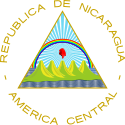
José Daniel Ortega Saavedra is a Nicaraguan politician serving as President of Nicaragua since 2007; previously he was leader of Nicaragua from 1979 to 1990, first as Coordinator of the Junta of National Reconstruction (1979–1985) and then as President (1985–1990). A leader in the Sandinista National Liberation Front, his policies in government have seen the implementation of leftist reforms across Nicaragua.

Nicaragua is the third least densely populated nation in Central America, with a demographic similar in size to its smaller neighbors. It is located about midway between Mexico and Colombia, bordered by Honduras to the north and Costa Rica to the south. Nicaragua ranges from the Caribbean Sea on the nation's east coast, and the Pacific Ocean bordering the west. Nicaragua also possesses a series of islands and cays located in the Caribbean Sea.
Liberalism has played a role in the political history of Israel since Israel's founding. Several liberal political parties have claimed substantial popular support, mainly proved by having representation in the Knesset. While liberalism is usually suspicious of nationalism, Jewish liberals in Israel generally support some form of Zionism.

Elections in Nicaragua gives information on elections and election results in Nicaragua.

The National Assembly is the legislative branch of the government of Nicaragua founded in 1986 to replace the bicameral National Congress of Nicaragua, which consisted of two chambers.

The Conservative Party is a conservative political party in Nicaragua. The party's colour is green and its emblem is a torch of freedom in a circle. Its slogan is “Dios, Orden, Justicia”, often depicted on the three sides of a triangle.

The Nicaraguan Liberal Alliance is a political coalition in Nicaragua. It was started in 2005 by Eduardo Montealegre and other members of the Constitutional Liberal Party who opposed former President of the country Arnoldo Alemán's continued control of the PLC even after he had been found guilty of misuse of public funds, and was sentenced to 20 years in prison. Montealegre also opposed the political alliance, commonly referred to as 'El Pacto', between Alemán as head of the PLC and Daniel Ortega, head of the Sandinist National Liberation Front.
The Neoliberal Party is a Nicaraguan neoliberal right-wing political party that split from the Independent Liberal Party (PLI) in 1986. PALI received legal status on appeal in 1989. In 2006, PLIUN was part of the Constitutionalist Liberal Party electoral alliance in the 2006 general election.

The Social Democratic Party is a right-wing Nicaraguan political party that split from Conservatives in 1979. The party sought affiliation to the Socialist International, but its application was rejected.

The Alliance for the Republic is a center-right liberal-conservative Nicaraguan political party founded in 2004 by dissident liberals from the Constitutional Liberal Party (PLC) and the Conservative Party (PC) including Enrique Bolaños, who was President of Nicaragua at the time.
The Nicaraguan Resistance Party is a Nicaraguan political party founded in 1993 by the Contras, the armed opposition to the Sandinista government in the 1980s.

A general election was held in Nicaragua on November 4, 1984, to elect a president and parliament. Approximately 1.2 million Nicaraguans voted, representing a 75% turnout, with 94% of eligible voters registered. Impartial observers from international groupings such as the European Economic Community, religious groups sent to monitor the election, and observers from democratic nations such as Canada and the Republic of Ireland concluded that the elections were completely free and fair.
General elections were held in Nicaragua to elect a president and National Congress of Nicaragua on 2 February 1947.
A general elections were held in Nicaragua to elect a President, half of the Deputies and 1/3 of the Senators of the National Congress of Nicaragua on 8 December 1936.
A general elections were held in Nicaragua to elect a President, half of the Deputies and 1/3 of the Senators of the National Congress of Nicaragua on 4 November 1928.

Presidential and parliamentary elections were held in Nicaragua on 6 November 2011. The incumbent president Daniel Ortega, won a third term in this election, with a landslide victory.










